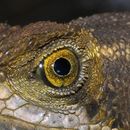en
names in breadcrumbs


This taxon occurs in the Rio Negro-Rio San Sun mangroves, which consists of a disjunctive coastal ecoregion in parts ofCosta Rica, extending to the north slightly into Nicaragua and south marginally into Panama. Furthermore, this species is not necessarily restricted to this ecoregion. Mangroves are sparse in this ecoregion, and are chiefly found in estuarine lagoons and small patches at river mouths growing in association with certain freshwater palm species such as the Yolillo Palm (Raphia taedigera), which taxon has some saline soil tolerance, and is deemed a basic element of the mangrove forest here. These mangrove communities are also part of a mosaic of several habitats that include mixed rainforest, wooded swamps, coastal wetlands, estuarine lagoons, sand backshores and beaches, sea-grasses, and coral reefs.
The paucity of mangroves here is a result of the robust influx of freshwater to the coastline ocean zone of this ecoregion. Among the highest rates of rainfall in the world, this ecoregion receives over six metres (m) a year at the Nicaragua/ Costa Rica national border. Peak rainfall occurs in the warmest months, usually between May and September. A relatively dry season occurs from January to April, which months coincides with stronger tradewinds. Tides are semi-diurnal and have a range of less than one half metre.
Mangroves play an important role in trapping sediments from land that are detrimental to the development of both coral reefs and sea grasses that are associated with them. Mangrove species including Rhizopora mangle, Avicennia germinans, Laguncularia racemosa, Conocarpus erecta and R. harrisonii grow alone the salinity gradient in appropriate areas. Uncommon occurrences of Pelliciera rhizophorae and other plant species associated with mangroves include Leather ferns Acrostichum spp., which also invade cut-over mangrove stands and provide some protection against erosion. In this particular ecoregion, the mangroves are associated with the indicator species, freshwater palm, Raphia taedigera. Other mangrove associated species are Guiana-chestnut ( Pachira aquatica) and Dragonsblood Tree (Pterocarpus officinalis).
Reptiles include the Basilisk Lizard (Basiliscus basiliscus), Caiman (Caiman crocodilus), Green Sea Turtle (Chelonia mydas), Leatherback Turtle (Dermochelys coriacea) and Green Iguana (Iguana iguana). The beaches along the coast within this ecoregion near Tortuguero are some of the most important for nesting green turtles. The offshore seagrass beds, which are among the most extensive in the world, are a source of food and refuge for the endangered Green Sea Turtle (Chelonia mydas). Several species of frogsof the family Dendrobatidae are found in this mangrove ecoregion as well other anuran species and some endemic salamander taxa.
Mammal species found in this highly diverse ecoregion include: Lowland Paca (Agouti paca), primates such as Mantled Howler Monkey (Alouatta palliata), Geoffrey's Spider Monkey (Ateles geoffroyi), White-faced Capuchin (Cebus capucinus), Brown-throated Sloth (Bradypus variegatus), Silky Anteater (Cyclopes didactylus) and Nine-banded Armadillo (Dasypus novemcintus).Also found in this ecoregion are carnivores such as Ocelot (Leopardus pardalis),Central American Otter (Lutra annectens), Jaguar (Panthera onca), Northern Racooon (Procyoon lotor), and Crab-eating Racoon (P. cancrivorus).